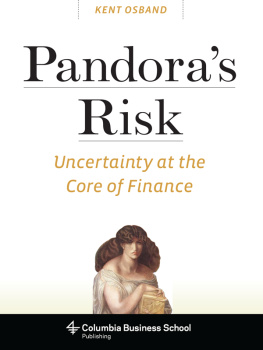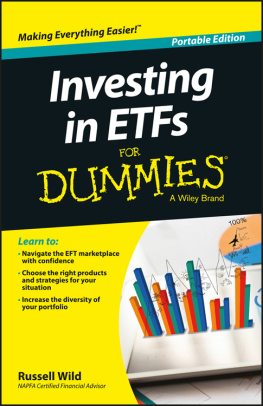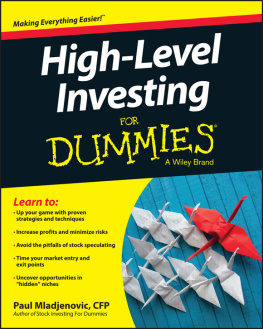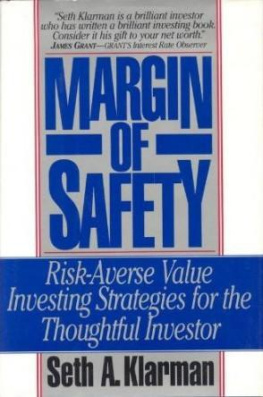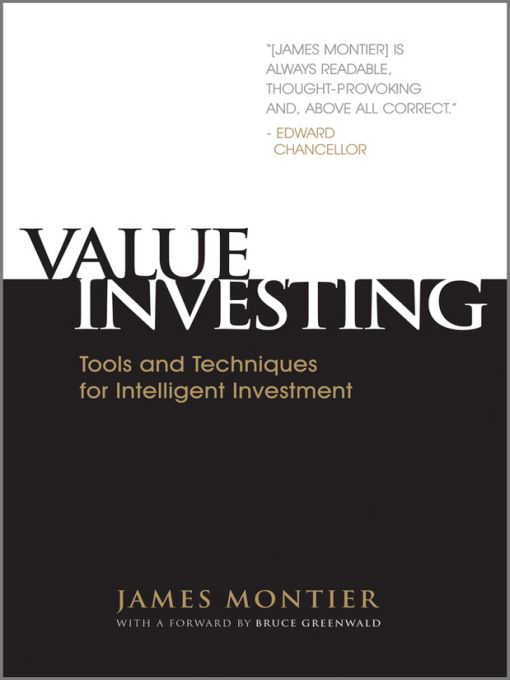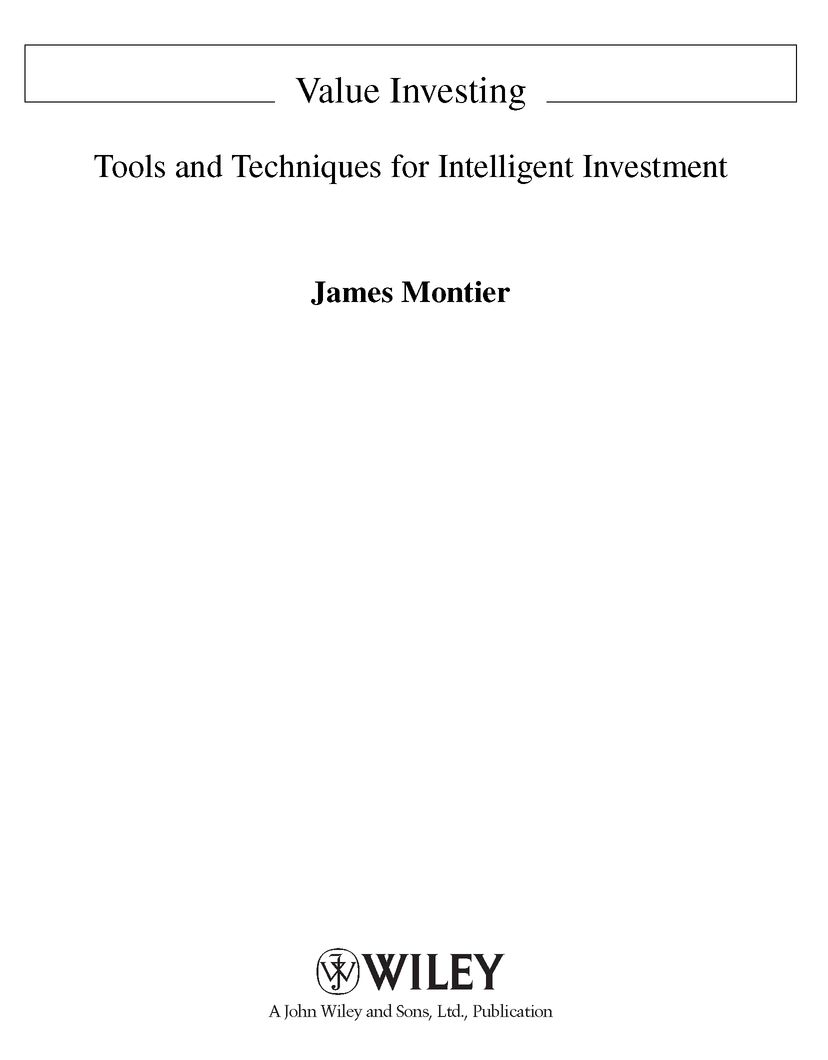Table of Contents
To Wendy
With all my love
Preface
Part I: Why everything you learned in business school is wrong
In fairness I should have entitled Part I Why Everything you Learned in Business School is Wrong (unless you went to Columbia). Equally well I could have used the title Six Impossible Things Before Breakfast.
The seductive elegance of classical finance theory is powerful, yet value investing requires that we reject both the precepts of modern portfolio theory (MPT) and almost all of its tools and techniques. The existence of MPT wouldnt bother me nearly as much as it does, if real-world investors didnt take its conclusions into investment practice. Sadly, all too often this is exactly what happens. Unfortunately, the prescriptions of MPT end up thwarting the investor. They lead us astray from the things on which we really should be concentrating.
Milton Freidman argued that a model shouldnt be judged by its assumptions but rather by the accuracy of its predictions. The chapters in Part I attempt to demonstrate that the basic edicts of MPT are empirically flawed. The capital asset pricing model (CAPM), so beloved of MPT, leads investors to try to separate alpha and beta, rather than concentrate upon maximum after tax total real return (the true object of investment). The concept that risk can be measured by price fluctuations leads investors to focus upon tracking error and excessive diversification, rather than the risk of permanent loss of capital. The prevalent use of discounted cash flow models leads the unwary down the road of spurious accuracy, without any awareness of the extreme sensitivity of their models. As Third Avenue Management put it: DCF is like the Hubble telescope, if you move it an inch you end up studying a different galaxy. Thus, following MPT actually hinders rather than helps the investor.
Part II: The behavioural foundations of value investing
MPT holds that all returns must be a function of the risk entailed. Thus, the believers in this approach argue that the outperformance of value stocks over time must be a function of their inherent riskiness. Ive always thought that this was a classic example of tautological thinking. The chapters in Part II attempt to demonstrate an alternative perspective - that the source of the value outperformance is a function of behavioural and institutional biases that prevent many investors from behaving sensibly.
We will cover the most dangerous (and one of the most common) errors that investors make - overpaying for the hope of growth (or capitalizing hope if you prefer). The chapters in Part II also try to provide you with the tools to enable you to start thinking differently about the way you invest. Value investing is the one form of investing that puts risk management at the very heart of the approach. However, you will have to rethink the notion of risk. You will learn to think of risk as a permanent loss of capital, not random fluctuations. You will also learn to understand the trinity of sources that compose this risk: valuation, earnings and balance sheets.
In Part II we will also try to introduce you to ways of overriding the emotional distractions that will bedevil the pursuit of a value approach. As Ben Graham said: The investors chief problem - and even his worst enemy - is likely to be himself.
Part III: The philosophy of value investing
The chapters in Part III set out the core principles involved in following a value approach. The first chapter lays out the 10 tenets of my approach to value investing, and details the elements you will need to be able to display if you intend to follow the value approach:
Tenet I: Value, value, value
Tenet II: Be contrarian
Tenet III: Be patient
Tenet IV: Be unconstrained
Tenet V: Dont forecast
Tenet VI: Cycles matter
Tenet VII: History matters
Tenet VIII: Be sceptical
Tenet IX: Be top-down and bottom-up
Tenet X: Treat your clients as you would treat yourself
The remaining chapters explore some of the issues in more depth, such as the need for patience, and the need to think independently. One of the most important chapters in Part III concerns the role of process versus outcomes. As we have no control over outcomes, the only thing we can control is the process. The best way to achieve good outcomes is to have a sensible investment process as this maximizes the chances of success. As Ben Graham said: I recall... the emphasis that the bridge experts place on playing a hand right rather than playing it successfully. Because, as you know, if you play it right you are going to make money and if you play it wrong you lose money - in the long run.
Part IV: The empirical evidence
Nassim Taleb talks about the need for empirical scepticism. This, in effect, is a desire to check your beliefs against the evidence. The two chapters in Part IV provide a very brief look at the evidence on value investing. The first looks at the proposition that an unconstrained global approach to value investing can create returns. The second considers a deep value technique, much loved by Ben Graham, and shows that it still works today (a direct response to those who argue that Grahams approach is outdated or outmoded). I could have included additional chapters in Part IV, but many excellent surveys on the evidence supporting value investing are easily available to the interested reader. The ultimate proof of the value approach is that almost all (if not all) of the worlds most successful investors take a value approach. As Warren Buffett opined:
I would like you to imagine a national coin-flipping contest. Lets assume we get 225 million Americans up tomorrow morning and we ask them all to wager a dollar. They go out in the morning at sunrise, and they all call the flip of a coin. If they call correctly, they win a dollar from those who called wrong. Each day the losers drop out, and on the subsequent day the stakes build as all previous winnings are put on the line. After ten flips on ten mornings, there will be approximately 220,000 people in the United States who have correctly called ten flips in a row. They each will have won a little over $1,000.
Now this group will probably start getting a little puffed up about this, human nature being what it is. They may try to be modest, but at cocktail parties they will occasionally admit to attractive members of the opposite sex what their technique is, and what marvellous insights they bring to the field of flipping.
Assuming that the winners are getting the appropriate rewards from the losers, in another ten days we will have 215 people who have successfully called their coin flips 20 times in a row and who, by this exercise, each have turned one dollar into a little over $1 million. $225 million would have been lost, $225 million would have been won.
By then, this group will really lose their heads. They will probably write books on How I Turned a Dollar into a Million in Twenty Days Working Thirty Seconds a Morning. Worse yet, theyll probably start jetting around the country attending seminars on efficient coin-flipping and tackling skeptical professors with, If it cant be done, why are there 215 of us?
By then some business school professor will probably be rude enough to bring up the fact that if 225 million orangutans had engaged in a similar exercise, the results would be much the same - 215 egotistical orangutans with 20 straight winning flips.


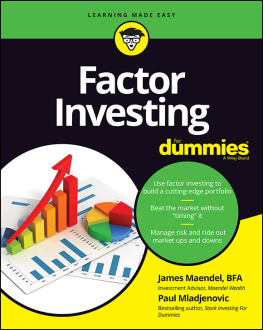
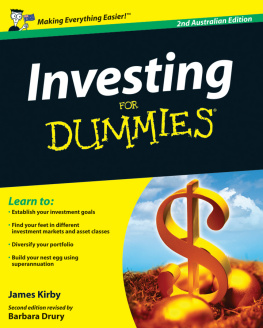
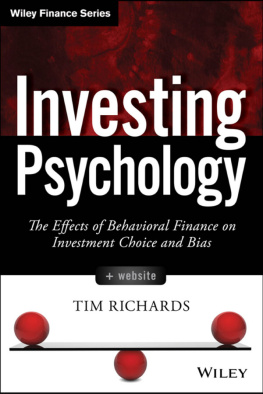
![Tim Richards [Tim Richards] - Investing Psychology: The Effects of Behavioral Finance on Investment Choice and Bias, + Website](/uploads/posts/book/124122/thumbs/tim-richards-tim-richards-investing-psychology.jpg)
